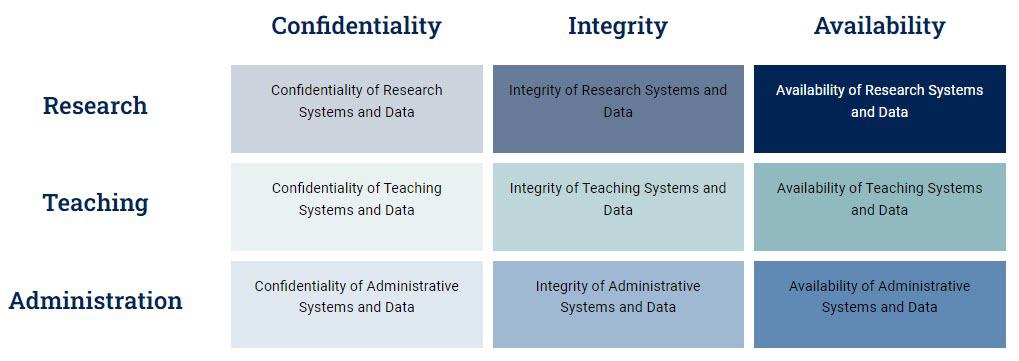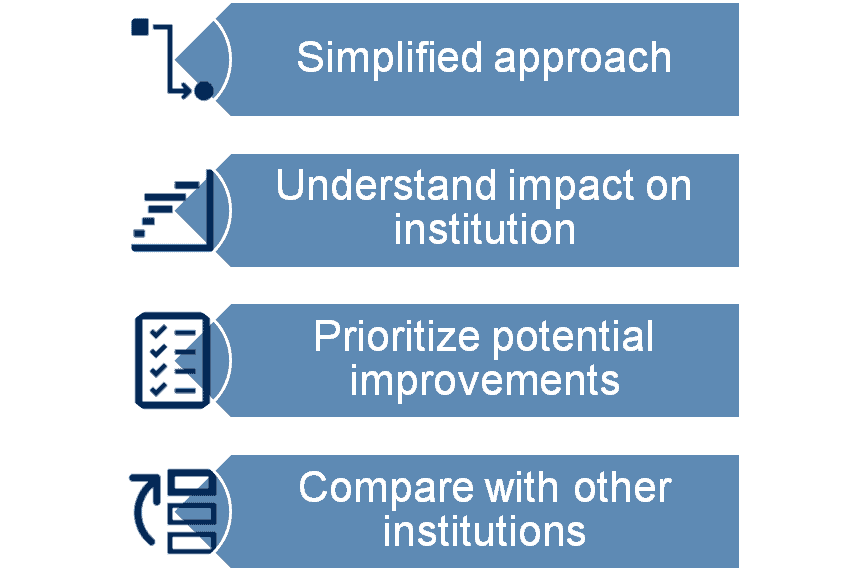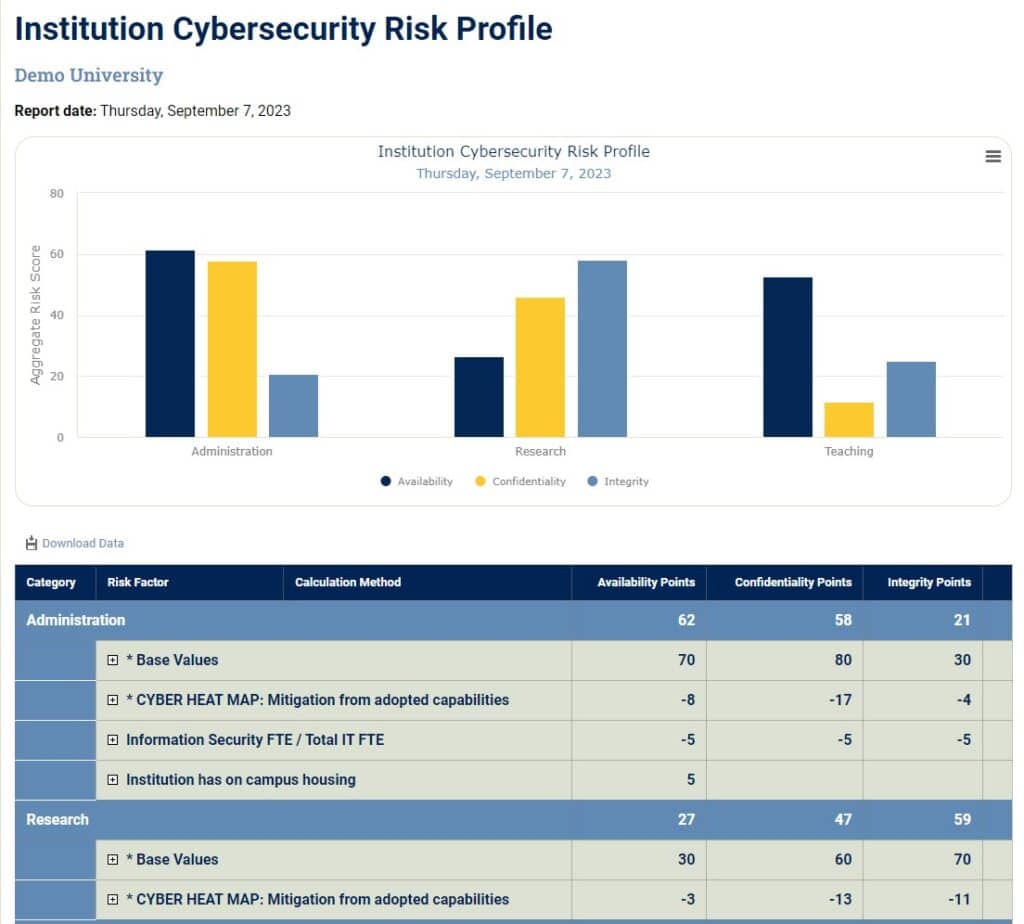Introduction
We’re excited to introduce CampusCISO Risk Profiles: a new tool that helps our members simplify how they incorporate cybersecurity risk into their strategy and planning processes.
The Risk Profile helps you understand how a cybersecurity event could affect various functions of your institution and to prioritize potential improvements based on this information.

Understanding the CampusCISO Risk Profile
The CampusCISO Risk Profile compares the relative cybersecurity risk exposure your institution has across three primary functions:
- the research mission,
- the teaching mission, and
- the administration of the institution.

The Risk Profile report streamlines how you understand and quantify relative risk to confidentiality, availability, and integrity across each of these functions. We refer to each of these combinations of function and risk type as a “risk segment.” For example, the confidentiality of administrative data and systems would be one segment in the CampusCISO Risk Profile.
Besides giving you a picture of relative risk, we also incorporate these scores into our Improvement Recommendations report to help you prioritize potential cybersecurity investments. This helps you choose between potential projects based on how each improvement can reduce risk.
How does it work?
We built the Risk Profile into the CYBER HEAT MAP assessment and planning tools. We compare your assessment answers with data from the U.S. Department of Education IPEDS database, the National Science Foundation HERD Survey, and anonymized assessment data from other CampusCISO members.
When you save an assessment snapshot, we calculate your relative risk scores using a model developed with input from over a dozen higher education institutions. This risk model evaluates hundreds of variables, comparing your assessment answers with benchmark data from IPEDS, HERD, and other CampusCISO users.
Integrate risk assessments into your planning process
We help you incorporate risk as part of the CYBER HEAT MAP capability assessment. Members usually complete their initial assessment in 4 to 8 hours. Once you’ve entered your answers, you can save a point-in-time snapshot.
And that’s it!
You don’t need to provide additional risk information to use the new Risk Profile feature. Once you save your snapshot, we also save your Risk Profile scores based on your data and the thousands of higher education comparison benchmarks we’ve collected.
Key benefits of using the CampusCISO Risk Profile

One of the biggest benefits you get from CampusCISO is simplicity. You don’t need to compile and analyze data from IPEDS, HERD, and by manually collecting information from peers. We’ve already built risk calculations into the CYBER HEAT MAP framework.
The Risk Profile report helps you understand what areas of your institution’s operations are exposed if you experience a cybersecurity incident, what attributes of the institution contribute to this vulnerability, and how the cybersecurity capabilities you’ve deployed help to mitigate your risk.
We incorporate your risk scores into our Improvement Recommendations report. This helps you prioritize improvements that have the biggest impact on reducing risk and improving your cybersecurity maturity. And this is all based on the unique characteristics of your institution.
Finally, the Risk Profile Benchmark report helps you compare your relative risk characteristics with other higher education institutions. The report also helps you track your risk profile over time, showing how your cybersecurity investments have helped you mitigate risk.
Comparing CampusCISO Risk Profile with other risk assessment tools and methods
We designed the CampusCISO Risk Profile feature to support the unique needs of higher education by providing affordable assessment and planning tools that simplify how you plan your cybersecurity strategy.
Relative Risk Exposure vs
Modeling Cybersecurity Financial Risk

Many commercial IT risk assessment tools can help you estimate and quantify a financial impact from your cyber risks.
But how do you quantify the impact of classrooms being disrupted? Or the potential loss of irreplaceable cancer research data? These outcomes are clearly bad for the institution, but they don’t cause a direct financial cost.
The Pareto principle proposes that you get most of the value from doing an activity from a small fraction of the effort. We applied this same principle to our Risk Profile features.
That’s why we focused on helping you understand relative risk exposure as it relates to disruption of your core teaching, research, and administration functions.
Dedicated IT risk management tools can produce more detailed financial models , but you can still gain significant risk management benefits while undertaking a fraction of the effort of these more complex approaches.
Affordable Solutions for Higher Education

Which brings us to another goal of CampusCISO: affordability. We intentionally built our tools and services to deliver cost-effective solutions that support the unique needs of higher education institutions.
The Risk Profile features are no exception.
Even with our free CampusCISO Community membership, you can benefit from the new Risk Profile. Your risk scores are one factor we incorporate into the Improvement Recommendations report after you save your assessment data.
And, if you want to use the detailed Risk Profile and Risk Profile Benchmarking reports, our premium memberships start at just $999/year compared to IT risk management tools that often cost $50K or more per year.
Who can benefit from using the Risk Profile reports?
We designed CampusCISO for CIOs and CISOs who plan an institution’s cybersecurity strategy. However, you can use the Risk Profile reports when you discuss your information security posture with other key executives at your institution such as the CFO, auditors, and risk management teams.
We know that higher education cybersecurity teams face challenges, such as limited staff and budget, time-consuming assessment and audit processes, and lack of familiarity with data sources you could leverage to analyze your risk. The CampusCISO Risk Profile addresses these challenges by providing an affordable tool that simplifies how you evaluate your cybersecurity capabilities and plan your improvement strategy.
Conclusion
The CampusCISO Risk Profile helps higher education institutions better understand their cybersecurity risks and prioritize improvements based on this understanding. We invite you to try out this new feature and see how it can benefit your institution.
Have questions about how the Risk Profile would work at your institution? We’re happy to help you explore your needs to see if we’re a fit! You can book a free consultation using the link below.

